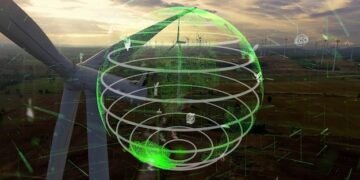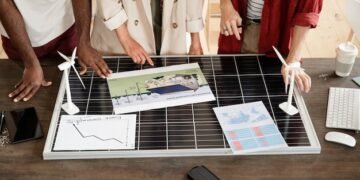Green Savings: Eco-Friendly Investments & Tax Credits for 2025

Green savings in 2025 encompass eco-friendly investments and leveraging tax credits to promote both financial and environmental well-being, offering opportunities for individuals and businesses to contribute to sustainability while securing tax benefits and financial growth in environmentally conscious sectors.
Green savings: Eco-Friendly Investments and Tax Credits of 2025 represent a pivotal intersection of environmental consciousness and financial prudence. As we advance into 2025, understanding how to leverage eco-friendly investments and tax credits is crucial for both individual financial well-being and contributing to a sustainable future.
Understanding Eco-Friendly Investments in 2025
Eco-friendly investments have evolved beyond niche markets, now representing a significant portion of the investment landscape. These investments not only offer financial returns but also contribute to positive environmental and social outcomes. Understanding the breadth and depth of these opportunities is crucial for investors looking to align their portfolios with their values.
Renewable Energy Investments
Investing in renewable energy sources like solar, wind, and hydroelectric power is a direct way to support sustainable energy. These investments can take various forms, from direct equity in renewable energy companies to bonds financing renewable energy projects.
Sustainable Agriculture
Sustainable agriculture focuses on farming practices that minimize environmental impact while ensuring food security. Investments in this sector can include companies developing innovative farming technologies, organic food producers, and sustainable land management projects.
- Investing in companies focused on vertical farming and hydroponics.
- Supporting local farmers markets and community-supported agriculture (CSA) programs.
- Choosing agricultural bonds that prioritize soil health and reduced pesticide use.
The future of eco-friendly investments involves technological innovations and wider market adoption, creating further opportunities for growth and impact. As environmental awareness increases, these investments are poised to become even more significant in shaping a sustainable future.
Exploring Tax Credits for Green Initiatives
Tax credits play a pivotal role in incentivizing green initiatives, and 2025 offers a range of opportunities for individuals and businesses to reduce their tax burden while contributing to a more sustainable environment. These credits cover various activities, from energy efficiency improvements to the adoption of renewable energy systems.
Residential Energy Credits
Homeowners can take advantage of tax credits for installing energy-efficient appliances, solar panels, and other renewable energy systems. These credits not only lower the upfront costs of these improvements but also reduce long-term energy expenses.
Commercial Energy Credits
Businesses are also eligible for tax credits related to energy efficiency and renewable energy adoption. These credits can significantly reduce the cost of investing in sustainable technologies and practices, making it more financially viable for companies to go green.

- Implementing energy-efficient lighting systems to reduce electricity consumption.
- Investing in high-efficiency HVAC systems that qualify for tax incentives.
- Implementing green building practices in construction and renovation projects.
Tax credits act as a financial catalyst for sustainable actions, encouraging both individuals and businesses to invest in eco-friendly technologies and practices. By understanding and utilizing these credits, taxpayers can contribute to a greener future while improving their financial bottom line.
Maximizing Savings with Energy-Efficient Upgrades
Investing in energy-efficient upgrades is a smart way to reduce energy consumption and lower utility bills. In 2025, there are various opportunities to enhance energy efficiency in both homes and businesses, leading to significant savings and environmental benefits.
Home Energy Audits
A home energy audit can identify areas where energy is being wasted, allowing homeowners to prioritize upgrades that will yield the greatest savings. These audits typically assess insulation levels, air leaks, and the efficiency of appliances and heating/cooling systems.
Energy-Efficient Appliances
Upgrading to energy-efficient appliances, such as refrigerators, washing machines, and dishwashers, can significantly reduce energy consumption. Look for appliances with the Energy Star label, which indicates they meet strict energy-efficiency standards.
Conducting a thorough energy audit to identify areas of improvement.
Replacing old windows with energy-efficient models to reduce heat loss.
Investing in smart thermostats to optimize heating and cooling schedules.
Energy-efficient upgrades provide a double benefit: they reduce energy costs and minimize environmental impact. By taking advantage of available rebates and incentives, homeowners and businesses can make these investments even more cost-effective.
The Role of Green Bonds in Sustainable Investing
Green bonds are a type of fixed-income instrument specifically designed to finance projects with environmental benefits. As sustainable investing gains traction, green bonds have become an increasingly popular option for investors looking to support environmentally friendly initiatives while earning a return.
Green bonds offer investors a way to directly support sustainable projects, such as renewable energy facilities, energy-efficient buildings, and sustainable transportation systems. These bonds provide transparency, as the proceeds are earmarked for specific green projects.
Investing in green bonds can align your portfolio with your values while providing a stable source of income. These bonds contribute to positive environmental outcomes, fostering a more sustainable future.

- Evaluating the issuer’s environmental track record and commitment to sustainability.
- Assessing the project’s environmental impact and potential for positive change.
- Prioritizing bonds with strong verification and reporting standards.
Green bonds represent a powerful tool for channeling capital towards sustainable development. By investing in these bonds, investors can contribute to a greener future while achieving their financial goals.
Navigating Sustainable Investment Options
Sustainable investing encompasses a range of strategies aimed at generating financial returns while considering environmental, social, and governance (ESG) factors. Navigating these options requires a clear understanding of different approaches and their potential impact.
ESG investing involves incorporating environmental, social, and governance factors into investment decisions. This approach seeks to identify companies that are well-managed, socially responsible, and environmentally sustainable.
Impact investing focuses on generating measurable social and environmental impact alongside financial returns. This type of investing targets specific outcomes, such as reducing poverty, promoting clean energy, or improving access to healthcare.
Screened funds are investment funds that exclude companies involved in activities that are deemed unethical or harmful, such as fossil fuels, tobacco, or weapons. This approach allows investors to align their portfolios with their values by avoiding industries that conflict with their beliefs.
By staying informed and seeking professional advice, investors can navigate the landscape of sustainable investment options and create portfolios that reflect their values and contribute to a more sustainable world.
Preparing for Green Savings in 2025
As we approach 2025, it’s essential to prepare for the opportunities and challenges in the realm of green savings. Staying informed about policy changes, technological advancements, and market trends will be crucial for maximizing your environmental and financial impact.
Keep abreast of changes in tax regulations that may affect your green investments and savings. Stay informed about any new tax credits or incentives that could benefit your sustainable initiatives.
Explore how technology can enhance your green savings efforts. Consider using smart home devices, energy management systems, and other tools to reduce your environmental footprint and lower your expenses.
Explore how technology can enhance your green savings efforts. Consider using smart home devices, energy management systems, and other tools to reduce your environmental footprint and lower your expenses.
- Engage with relevant associations and organizations to stay updated on sustainable investing trends.
- Attend industry conferences and webinars to learn from experts and network with peers.
- Read reputable publications and blogs that cover green finance and sustainable business practices.
By taking proactive steps to prepare for the future, individuals and businesses can effectively leverage green savings to achieve both environmental and financial goals. Embrace the opportunities ahead and make informed decisions to contribute to a more sustainable world.
| Key Point | Brief Description |
|---|---|
| 🌱 Eco-Friendly Investments | Investing in renewable energy, sustainable agriculture, and green technologies. |
| 💰 Tax Credits for Green Initiatives | Leveraging residential and commercial energy credits to incentivize sustainable practices. |
| 💡 Energy-Efficient Upgrades | Maximizing savings with home energy audits and energy-efficient appliances. |
| 🌍 Green Bonds | Investing in fixed-income instruments designed to finance environmental projects. |
Frequently Asked Questions
▼
Eco-friendly investments include renewable energy projects like solar and wind farms, sustainable agriculture initiatives, and green technology companies. These investments support environmentally beneficial activities.
▼
You can benefit by claiming tax credits for installing solar panels, upgrading to energy-efficient appliances, and making other energy-saving home improvements. Businesses can also claim credits for adopting green technologies.
▼
A home energy audit assesses your home’s energy efficiency and identifies areas for improvement. By addressing issues like poor insulation and air leaks, you can reduce energy waste and lower your utility bills.
▼
Green bonds are fixed-income instruments that finance environmental projects. Investing in them allows you to support sustainable initiatives while earning a return. They provide transparency and direct environmental impact.
▼
Stay updated by following policy changes, reading industry publications, and engaging with relevant organizations. Participate in webinars and conferences to learn from experts and network with peers in the green finance sector.
Conclusion
In conclusion, embracing green savings: Eco-Friendly Investments and Tax Credits of 2025 is essential for a sustainable and financially sound future. By understanding and utilizing the available options, individuals and businesses can contribute to environmental preservation while achieving their financial goals.





